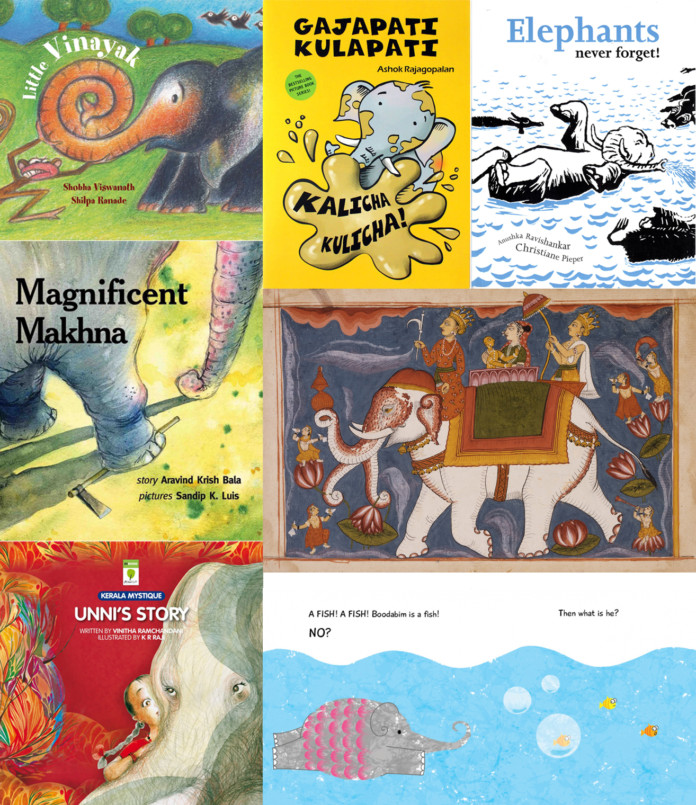“Bow your head. Show them respect. The elephants created this jungle. Where they made furrows with their tusks the rivers ran. Where they blew with their trunks the leaves fell. They made all,” ~ Bagheera in The Jungle Book.
Elephants have an inscrutable appeal to humans, and children’s literature has a special place for them. From Ashok Rajagopalan’s bestselling Gajapati Kulapati series to Alankrita Jain’s whimsical Boodabim – a quick look at some of India’s most-loved children’s books throws up a formidable collection of stories built around elephants. What makes these behemoths fascinating protagonists for children’s book writers?
For many it’s the elephant’s unique form – massive bodies, humongous flappy ears and an amazingly versatile trunk – that instantly lends itself to imaginary exploits and endearing illustrations. Author Shobha Viswanath emphatically asserts that she is yet to meet a child who does not love the elephant! Her book Little Vinayak with a baby elephant who trips over his unusually long trunk, is a perfect example of the elephant’s peculiar shape leading itself to interesting narratives. In Aana and Chena, Sowmya Rajendran has Aana, the elephant lamenting over his looks to ring in the beauty in our uniqueness.
But what makes elephants truly distinctive is that despite their colossal form, they are widely perceived as gentle giants, reigning raw power with restraint and kindness. With their huge heads and wrinkled skin, they embody wisdom and patience. They uproot vegetation, create watering holes and reshape landscapes as they sway and walk owning time itself. Ashok Rajagopalan concurs, attributing the elephant’s popularity to not just being the largest animal one sees on land but also to its palpable gentleness. He adds that elephant calves are delightful and usually naughty, and a baby elephant like Gajapati from his bestselling series would be easily adored.
Elephants also exhibit remarkably relatable family structures. It is fascinating to see them not just communicate but mentor calves, grieve their dead, reconcile after a fight, and collaborate to solve problems in their herds. Anushka Ravishankar’s Elephants Never Forget wittily gives this family bonding new meaning as a lost baby elephant finds a new home with a herd of water buffaloes.
Often these attributes are an outcome of enduring religious symbolism. Elephants are central to Buddhist and Hindu mythologies and even permeate Chinese, Burmese and Thai cultures. The elephant-headed Lord Ganesha bestowed with the ability to remove all obstacles, Lord Indra mounted on his mighty white Airavat, temple elephants carrying gods in processions… it is easy to associate divinity and royalty with these giants. Indeed, there are several myths and legends surrounding elephants. In fact, a separate list can be curated on the books written about Lord Ganesha alone!
While elephants are favourites within Indian children’s literature, outside the pages of books, they are threatened by an upsurge in ivory poaching, vanishing elephant corridors and increasingly fragmented landscapes giving rise to human-animal conflicts. Aravind Krish Bala’s Magnificent Makhna speaks of an elephant turning into a feared beast when faced with tree-cutters and poachers, to ensure the forests thrive under its kind, watchful eye, while Vinitha Ramchandani’s Unni’s Story has a little girl rescue and adopt a wounded baby elephant only to realise that she needed to let it go.
It is essential that while we read their delightful tales, we also take time to reflect upon the future of this precious pachyderm. After all, no child would want beloved Gajapati to be an extinct species!
Not-to-be missed elephant tales
- Gajapati Kulapati
- How to weigh an elephant
- Aana and Chena
- An Elephant In My Backyard
- Boodabim
- Magnificent Makhna
- Elephants Never Forget
- A Pair Of Twins
- Unni’s Story
- Toomai of the Elephants (A short story from The Jungle Book)
- Uncle Nehru, Please send an Elephant!
- Little Vinayak
- The Elephant in the Tree
- Speaking to an Elephant and Other Tales from the Kadars
- What Shape Is An Elephant?
- That Summer at Kalagarh
- Walk the Grasslands with Takuri










